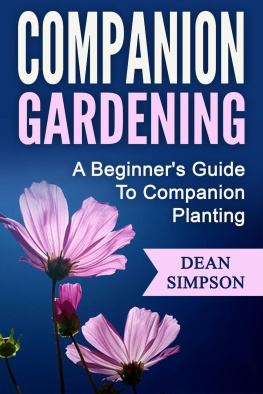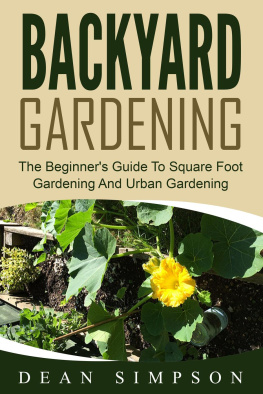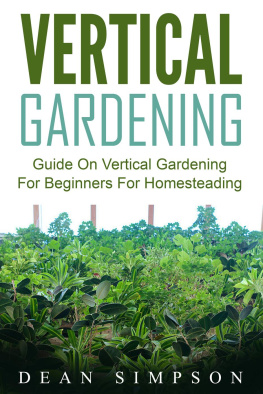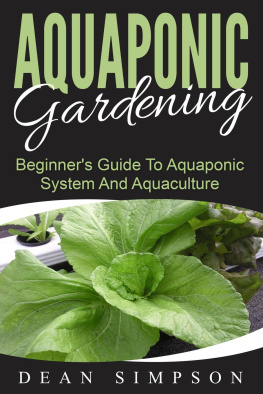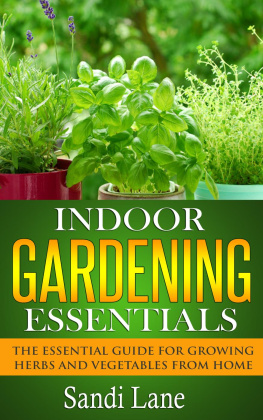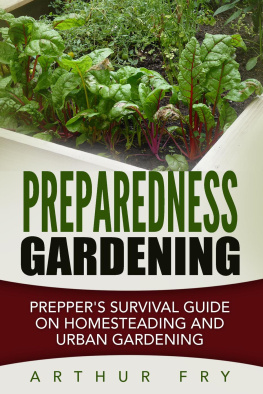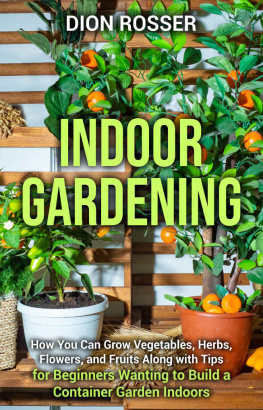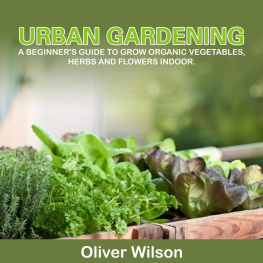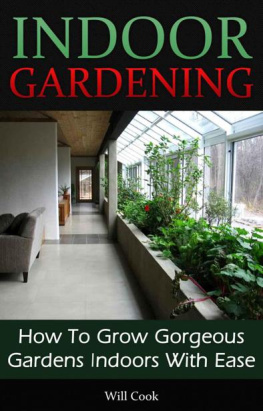Indoor Kitchen Gardening
While every precaution has been taken in the preparation of this book, the publisher assumes no responsibility for errors or omissions, or for damages resulting from the use of the information contained herein.
INDOOR KITCHEN GARDENING: A COMPLETE GUIDE ON ORGANIC GARDENING FOR HOMESTEADING INDOORS
First edition. March 14, 2017.
Copyright 2017 Dean Simpson.
Written by Dean Simpson.
10 9 8 7 6 5 4 3 2 1
Introduction
G ardening can be viewed as both a hobby and a passion. Some like to look at it as a means to save money as gardening can help you grow self-sufficient. Whatever be your reason, starting a kitchen garden is always a good idea and one that will help you achieve many purposes.
A kitchen garden can be both indoors and outdoors. The latter will require an outside space while the former will just require a sunny windowsill.
In this book, we will focus on the latter and look at how you can start an indoor kitchen garden with ease.
Let us begin.
Chapter 1: Starting a Kitchen Garden
F irst and foremost, I wish to thank you for choosing this book and hope you have a great time reading it.
In this first chapter, we will look at some of the basic steps that you have to implement in order to start your own kitchen garden.
Planning
P lanning is extremely important when you wish to start your kitchen garden, or any garden for that matter. You have to have a set plan in place that will guide you to make your next move. If you go about it without knowing what to do next then you will simply be lost. Instead, spending just an hour or two for a couple of days and deciding on everything before starting your kitchen will help you get started with your kitchen in the best manner possible. You can take the help of a friend who is good at gardening to plan out your gardening schedule.
Layout
T he next step is for you to plan the layout of the garden. This refers to knowing what to plant and where. You obviously need to plant your plants under the right conditions in order for them to thrive. Start by looking at the lighting that is available. Your plants will require ample natural light in order to thrive. Next, look at the availability of water. You have to be able to water your plants easily and not make it a cumbersome task. Next, the overall conditions prevailing in the room will also play a big part in the growth and maintenance of your garden. You have to find a warm, humid spot for some whereas a cool and shady area for some others. So ensure that both these are available within the confines of your kitchen.
Budget
T he next step is to set a budget for your kitchen garden. You have to choose a budget that will suit your resources. Some like to start small and then build up on the idea while some others prefer to go all out and splurge on their kitchen garden. Whatever your choice is, you have to remain within a set budget and try not to over shoot it. Take the help of your partner or spouse to come up with the ideal budget and also to stick with it.
Supplies
N ext, you have to make a list of all the supplies that you will need. Ideally, this list should be prepared during the first step of this process. Once you have the list, you can take it with you to the store and start ticking off one item after another. Try to buy all the best supplies that your money can buy in terms of quality and quantity. You might have to do a little research to zero in on the best place to buy these supplies. Online stores are also a great choice as you can find a large variety at cheaper prices. When it comes to buying the seeds, look for high quality ones with a greater germination rate. That is sure to help you have a better yield.
Planting
T he next step is for you to plant the seeds. Each plant has its own technique and you have to follow the one that matches the one you are trying to plant. This book will guide you through some of the basic plants that can be grown within your indoor kitchen garden. But for any other plant, you can do a short search on the Internet to find the right technique. Once you find it, make a note of it so that you know exactly what to do with the seeds.
Nurturing
I t is extremely important for you to nurture a plant even if it is growing right in front of your eyes. You have to give it some tender loving care in order to ensure that the plant is doing well. You have to provide it with all the right conditions and nurture it from time to time. Talking to your plants or playing music for them is both beneficial and you will be left with a bigger and better produce at the end of it. Take some time out from your everyday schedule to do the same and remain with a bustling garden. Make sure you provide the plants with the right nutrients and also check for insects and weeds.
Harvesting
T he next step is for you to harvest your garden. Harvesting refers to carefully removing all the produce without damaging the plant. Be careful with it and make use of soft hands. You want your plants to give you another round or two of the produce and for that you have to be a little careful with it. You have to know exactly when to harvest the different produce to make sure that you arent left with under or over ripe vegetables.
Storage
Y ou have to find storage option for your produce. You will obviously not be using everything at the same time and will have to store them to be used later. For this, you must make use of storage options such as canning and dehydrating. We will delve into the details of these in the very last chapter of this book.
Diversification
D o not limit yourself to just the plants that you have in your garden and expand it consistently. You should buy newer plant varieties and plant them in your garden. Diversifying can help you maintain a unique and interesting garden, which will not bore you easily.
These form the different steps that you have to take in order to start your kitchen garden.
Chapter 2: Vegetables for your Kitchen Garden
T here are many vegetables that you can pick for your indoor kitchen garden. Here are some of the best and easiest ones.
Pepper
P eppers are great for any kitchen garden let alone indoor ones. Peppers are low maintenance and will allow you to remain with a big produce at the end of the season. They like sunny spots and so, pick a windowsill that gets at least 3 hours of direct sun. You have to pick a variety that does well indoors. Fertilizing your pepper plant regularly will help you remain with a healthy produce all year round. You can wait for them to go green or pick them when they turn red. The former will be hotter than the latter.
Radishes
Y ou wont believe how easy it is to grow radishes. They will grow just as well both indoors and outdoors. You dont have to worry about the sun and other details, these are extremely hardy and you can remain with a big produce within a couple of months. The best part about radishes is that they give you two vegetables. First, you can harvest and consume the leaves, which are rich in multiple nutrients. Then, you can wait for the radishes to grow out and harvest them. It takes around 2 months for the radishes to grow fully in size before you can harvest them for a fuller taste.
Spring onions
S pring onions are easy to grow and require only shade. They will thrive in a sunny spot as well but is not a necessity. Spring onions are great as they can lend any dish a rich flavor. You can snip away at the leaves and add some to your salads. The onion bulbs can take some time to grow but once they do, they will make for great flavoring ingredients. Spring onions are extremely hardy and will not require any soil to grow. You can simply place them in a jug or water and they will grow just fine. You can simply sow a few buds in the soil and have them multiply.
Next page

